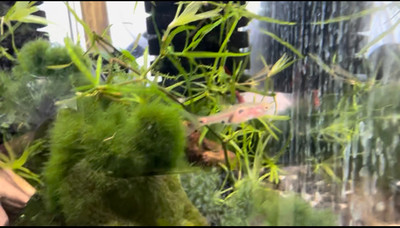Strawberry Rasbora (Boraras naevus)
Posted by Max Gandara on on 12th Dec 2023
Strawberry Rasbora (Boraras naevus):
- Species: Boraras naevus
- Genome: The Strawberry Rasbora belongs to the family Cyprinidae, known for its small size and vibrant coloration.
- Evolution Line: This species has adapted to freshwater
environments and is part of the diverse ecosystem of tropical and
subtropical regions.
Aquatic Life Summary:
The Strawberry Rasbora is a small, schooling fish with striking red hues
that make it a popular choice for aquarium enthusiasts. These peaceful
fish thrive in well-planted tanks with soft, acidic water. They exhibit
schooling behavior and appreciate a tank with ample hiding spaces. A
well-balanced diet, including quality flakes and small live or frozen
foods, contributes to their overall health.
Creating a Happy Environment :
- Tank Size: Optimal conditions in a tank of at least 10 gallons.
- Water Parameters: Maintain slightly acidic to neutral pH (6.0-7.0) and soft water.
- Plants: Provide dense vegetation for hiding and exploration.
- Filtration: Use a gentle filter to mimic their natural habitat.
- Tank Mates: Choose non-aggressive, small, and peaceful species to avoid stress.
Compatible Tank Mates Examples:
- Fish:
1. Dwarf Corydoras: Small, bottom-dwelling catfish that share the Rasboras' peaceful nature.
2. Cherry Shrimp: Hardy and colorful crustaceans that add vibrancy to the tank.
3. Neon Tetras: Similar in size and temperament, creating a visually appealing community.
4. Otocinclus Catfish: Algae-eating catfish that help maintain tank cleanliness.
5. Sparkling Gourami: Small labyrinth fish known for their calm demeanor.
- Crustaceans:
1. Amano Shrimp: Excellent algae eaters that coexist peacefully.
2. Red Crystal Shrimp: Colorful shrimp that thrive in similar water conditions.
3. Ghost Shrimp: Transparent and peaceful, complementing the Rasboras.
4. Bamboo Shrimp: Filter-feeding shrimp that add an interesting dynamic to the tank.
5. Thai Micro Crab: Small and non-aggressive, suitable for a community setup.
- Bugs:
1. Water Beetle Larvae: Aquatic insects that provide natural stimulation.
2. Daphnia: Tiny crustaceans that serve as live food and promote natural behavior.
3. Aquatic Isopods: Small scavengers that contribute to the tank's ecosystem.
4. Water Striders: Surface-dwelling insects that add activity to the tank.
5. Dragonfly Nymphs: Predatory insects in their nymph stage, adding excitement.
- Plants:
1. Java Moss: Easy-to-care-for moss that enhances the tank's aesthetics.
2. Anubias Nana: Hardy, low-maintenance plant providing shelter.
3. Cryptocoryne Wendtii: Adds visual appeal while creating hiding spots.
4. Water Sprite: Floating plant that provides shade and refuge.
5. Amazon Sword: Larger plant species offering hiding places and visual variety.
- Amphibians:
1. Dwarf African Clawed Frog: Small, aquatic frogs that cohabit peacefully.
2. Fire-Bellied Newt: Colorful newts that thrive in similar aquatic environments.
3. Axolotl: Unique aquatic salamanders known for their docile nature.
4. Dwarf Gourami: Labyrinth fish that complements the Rasboras' temperament.
5. Celestial Pearl Danio: Small, peaceful fish that share similar preferences.

